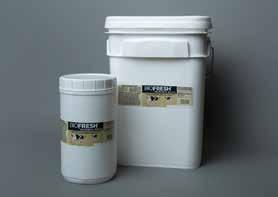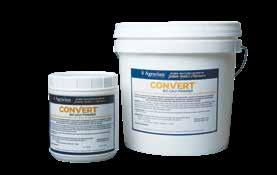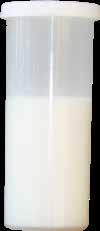The POINT
More convenient access to genomic testing

CentralStar recently partnered with Zoetis™ to bring dairy producers more convenient access to CLARIFIDE®, CLARIFIDE® Plus, and Herdity genomic testing.
“Partnering with Zoetis to help facilitate easier implementation of genomic testing aligns with Central-Star’s current offerings and mission of “enhancing producer profitability through integrated services,” said Phillip Dieter, chief executive officer, CentralStar Cooperative. “While this area of partnership is new for us, the CentralStar and Zoetis team members have been working collaboratively on dairies for years.”
Through this partnership, dairy producers in Michigan, Indiana, and Wisconsin can now work directly with their local CentralStar team to initiate a genomic-testing plan for their herd. A powerful tool to accurately identify the genetic merit of each animal in the herd, genomic-testing data pinpoints the best animals in the herd to use for developing the next generation, helping producers improve production, profitability, and sustainability.
“CentralStar consultants already provide guidance for genetic selection and inventory management on a vast number of dairies,” said Cole Mark, director of profit strategies at CentralStar. “Now
we can facilitate making genomic testing more convenient for the dairy, while providing our team more reliable tools to further accelerate the farm’s genetic progress.”


At the onset, genomic testing finds misidentification of animals, which leads to identifying the animals that are truly genetically superior for given traits. “Even with the best record keeping, identification errors occur,” said Mark. “On average, Zoetis has reported animal misidentification occurs approximately 18 percent

For use on purebred Holstein and Jersey cattle, CLARIFIDE
Plus includes parentage verification and reliable predictions from the Council for Dairy Cattle Breeding (CDCB) of all 50+ CDCB traits, including identifying animals with greater disease resistance through the proprietary Zoetis Wellness and Fertility traits. The genomic test delivers parentage and reliable predictions from CDCB of genetic merit in Holsteins, Jerseys, Brown Swiss, Guernseys, and crossbreeds of these makeups. HERDITY, an internal Zoetis evaluation, is designed for Holstein and Jersey crossbred animals, providing genomic sire and dam discovery, as well as production, fertility, longevity, and calf and cow wellness
Summer 2023
Photo: At Elsinger Dairy, Lomira, Wis. Susie Martin, CentralStar Regional Consulting Manager and Brenda Elsinger discuss the herd's genetic strategy which includes genomic testing.
Lameness: Challenge conventional thinking
Conventional thinking is considered tried and true, going unquestioned; but is that always the best approach?
Through National Animal Health Monitoring1, we know lameness is among one of the top-five reasons dairy cows leave the herd. Obviously, management practices play a big role, but so do genetics.
Historically, we’ve selected sires for traits like Foot Angle, Legs Side View, and Feet and Leg Composite (FLC). With years of experience, we should see improvement in the incidence of lameness, but we haven’t. Maybe, it’s time to challenge conventional thinking?

Studies to analyze lameness traits show indirect selection to improve lameness resistance, using a variety of conformation traits, hasn’t been effective. Fortunately, new tools that more directly address lameness resistance have been developed. Publicly available since 2016, Z-Lame is a lameness evaluation from Zoetis that represents data from health events recorded in a wide range of CLARIFIDE-tested, commercial-dairy farms. Lameness evaluations are expressed as standardized transmitting abilities (STAs) and usually range between 85 and 115, with 100 as the average. Higher values indicate more resistance to lameness and are preferred.
Validation studies published in the Journal of Dairy Science® document the predictive power of lameness evaluations.2

Additionally, Select Sires studied lameness evaluations and determined there was a positive correlation between STA values for lameness and predictive transmitting abilities (PTAs) for Productive Life (PL) and Livability (LIV).2 Simply put, cows with a higher Z-Lame score are the same cows that possess high PL and LIV traits. If you’re relying on confirmation traits to improve lameness resistance, it may be time to challenge conventional thinking. If you’re interested in learning more about this topic, talk to your CentralStar team. We also recommend reading Lameness Traits: Underused and Underestimated by Chuck Sattler, vice president of genetic programs, Select Sires, Inc.
health
Encourage feed-intake by cows pre and postfresh, off-feed or low feed intake periods

Re-establish digestive tract microbial balance after antibiotic usage
Support immune function during challenging periods
Sources: 1National Animal Health Monitoring, 2014. 2Lameness Traits: Underused and Underestimated, Chuck Sattler, vice president of genetic programs, Select Sires, Inc.
Z-Lame
hoof
Productive Life Cow Livability F&L Composite -0.10 -0.04 F&L Score -0.21 -0.19 Rear Legs SV -0.12 -0.01 Rear Legs RV -0.18 -0.13 Foot Angle -0.15 -0.26 Z-Lame 0.22 0.23 Correlation between F&L traits and longevity. All bulls with ≥ 100 PL daughters and Zoetis Lameness, 1,160
Buy 5 get 1 free June 1 - July 31, 2023 A Bolus
for improved
bulls. Microbial Gel
517.351.3180 | mycentralstar.com
PRODUCER
As a CentralStar A.I. Specialist, Brian Landis first used CONVERT BIG Calf Powder on his own calves. Liking the results, he began talking with producers he works with and shares what they had to say about using CONVERT BIG Calf.

"They say the calves gain way more weight in a much shorter time. This means they start to wean calves up to a week to 10 days earlier than before. Also, they notice the calves seem to have a stronger immune system due to much less sickness and pneumonia. These herds used to use multiple products in the milk for calves. They've since eliminated the other products, only use
BIG Calf, and are seeing far better results for much less money."
CONVERT BIG Calf Powder

• Promotes digestive tract and whole animal health and weight gain preweaning.
• Fosters starter-feed intake.
• Supports calves during transition and health challenges.
• Mix in whole milk or milk replacer from birth to weaning.
Exciting New Sires
Does it all with a unique pedigree backed by Kings-Ransom KB Delicate family!
DECREE (Wheelhouse x Fastball x Challenger)
Combines extreme components with powerful mastitis resistance!
MASTER (KASHTON x Acura x RESOLVE)
A superstar across the board for health traits, and a great udder improver!
RIMBOT (RIX x Sheldon x TAHITI)
Moderate frames and elite component production to make feed-efficient, long-lasting cows! 7HO16535 RECHARGE (ELON x Acura x Yoda)

The longevity of PARFECT with the elite production of LIONEL for ultimate customer satisfaction!
(PARFECT x LIONEL x YODER)
Enhancing producer profitability through integrated services.
14HO16519
+1,332 DWP$® 103 Z-Lame +6.9 PL +3037 GTPI® A2A2
14HO16660
+171 CFP +1,309 DWP$ 105 Z-Mast +7.7 PL +4.6 LIV
7HO16644
+2,117 M +178 CFP +6.5 PL 110 Z-Mast 1.6 SCE
+1,146 HHP$ +172 CFP 1.8 SCE +5.8 PL A2A2
+3233 GTPI +1,716 M +215 CFP +2.65 PTAT +2.30 UDC
7HO16468 PHOENIX
Picks
Join NxGEN® to accelerate genetic progress, while maximizing your herd's performance and profitability. Scan the QR code or talk to your CentralStar team to enroll.
The inside scoop on why CONVERT™ BIG Calf Powder is a favorite on farm.
CONVERT
4/23 CDCB & HA genomic evaluations. 5/23 Zoetis wellness evaluation. Visit selectsires.com for complete data and reliabiliites. 3
Three essentials your won’t get far without
Every time my husband leaves the house, he says out loud, “keys, wallet, cell phone.” Why? These are essential items he won’t get far without, but with them, he can get anywhere and accomplish anything.

On your dairy, what are the “keys, wallet, cell phone” for managing your herd and being profitable? As obvious as it may seem, the answer is milk weights, components, and somatic cell count (SCC) data. When you have these key pieces of information for every cow in the herd, it provides valuable insights into what else is going on at the cow level that can be managed.
Milk weights, components, and SCC are easily accessible through monthly DHI testing. If you already utilize DHI, you have the “keys, wallet, cell phone” to effectively manage your herd. Granted, the amount of data returned after a DHI test can be overwhelming, and just taking a quick glance at your Hotsheet during morning coffee may lead to missed opportunities to improve production and profitability. However, there are other tools, such as the DHI 402-Herd Evaluator report that gives you a more comprehensive, yet easy-to-read summary that helps you keep tabs on herd performance.
The Herd Evaluator report summarizes key areas that cover the top-six factors that affect profitability on Midwest dairies, according to a longitudinal study by Zoetis-Compeer Financial. Let’s dig into two of those factors: Energy-Corrected Milk (ECM) and SCC.
Milk Weights + Components = ECM
Figure 1 in the Herd Evaluator report gives you a quick visual to monitor trends in pounds of milk and components, which make
seems to have recovered by January, it has been decreasing the last three tests. Lastly, overall, this herd’s components are at or below the average, so there may be an opportunity to increase fat production.
Once you see the opportunities, you can begin to ask questions and take corrective action. If I were working with this herd as a consultant, I’d start with getting the “whole gang together” (key farm personnel, veterinarian, nutritionist, etc.) to review the data. Initial questions I would ask are: Have the herd dynamics changed in the last year, ( i.e. Do first-lactation cows make up a larger proportion of the herd?). Has there been a change to the ration that would explain the drop in Fat %? What are the herd’s goals for Combined Fat and Protein (CFP) and are they achieving it? Beyond the tactical mode, think about longer-term solutions to help these areas, like selecting genetics to make improvements with CFP, or longevity by using Herd Health Profit Dollars (HHP$™).
SCC
Next, let’s look at the report’s SCC analysis. We know that SCC is one of the top factors affecting dairy profitability and that many cooperatives offer incentives for high-quality milk with low SCC. As a consultant, I also see the effects high SCC can have on production and even reproduction.
In this herd, it looks like they identified the cause of the skyrocketing SCC last summer (Figure 3) and corrected it, but as we head into summer, it appears as if SCC is creeping up again, and we don’t want to repeat history. Does this farm have a good plan in place?
Looking at the data there are a variety of questions to pose to
dairy
and get ahead of any new mastitis-causing pathogens or an uptick in the usual bugs. Another consideration is to incorporate mastitis resistance genetics to build healthier cows.
There’s no arguing that the amount of data generated from DHI can be overwhelming, leading you to miss profit opportunities, but that doesn’t have to be the case. Using key-summary reports like the 402-Herd Evaluator helps you identify what’s important to monitor and manage, as well as how you compare to industry standards, helping you reevaluate your own goals. At an investment of pennies, a day, DHI is arguably one of the best investments you can make for your dairy.
If you are currently utilizing DHI, great, but make sure you are taking advantage of all the benefits it offers. If you are not yet routinely using DHI, why not? Like your keys, wallet, and cell phone, you won’t get far without individual-cow milk, components, and SCC data.
In subsequent articles, we will look at more key factors that affect profitability that are also summarized in the Herd Evaluator report.
Meet the author, Dr. Kelly Sporer


As a CentralStar Records Analysis Consultant, Kelly Sporer, PhD, analyzes farm data to provide custom solutions to producers. Previously, she worked as a Research Scientist leading research field trials and coordinating custom diagnostic testing strategies. Her previous research, specializing in stress, bovine immunology, Johne’s disease, and bovine leukosis, has been featured in numerous scientific and popular press journals. Kelly obtained her Bachelor of Science in Animal Science from Michigan State University and her PhD from University College Dublin in Ireland, investigating the effects of transportation stress on cattle immune function.
Learn more about DHI and the Herd Evaluator report.
Milk Yield Current Prev. Test 03-23 2022 Top 25% Affiliate Avg Daily Milk 98 101 106 96 88 150 Day Milk 100 103 107 99 92 Days in Milk (DIM) 166 161 159 152 171 Test Day Fat % 4.1 4.3 4.4 4.6 4.2 Test Day Protein % 3.2 3.2 3.2 3.4 3.2 Rolling Herd Avg Milk 33,050 33,230 33,146 30,360 28,246 Peak Milk 1st Lactation 98 98 96 96 88 Peak Milk 2nd Lactation 122 123 117 121 112 Peak Milk 3+ Lactation 130 130 129 130 120 Test Day Fat Corr. Milk 107 114 121 106 97 305d ME Milk 1st Lact 33,698 34,056 35,303 31,927 29,559 305d ME Milk 2nd Lact 35,916 36,483 36,645 33,590 31,050 305d ME Milk 3+ Lact 31,921 32,283 32,544 31,572 29,057
Figure 2
1 Apr May Average Daily Milk Per Lactating Cow 90 95 100 105 110 115 Milk lbs. Jun Jul Aug 120 Sep Oct Nov Dec Jan Mar Feb Mar Apr 3.4 3.6 3.8 4.0 4.2 4.4 4.6 3.0 3.2 Month (2022-2023) Milk Fat % Pro % Fat & Protein % Figure 3 Apr May Herd Somatic Cell Count 60 80 100 120 140 160 SCC x 1,000 Jun Jul Aug 180 Sep Oct Nov Dec Jan Mar Feb Mar Apr Month (2022-2023) SCC
Figure
Are the best animals your herd really the
 Susie Martin, Regional
Susie Martin, Regional

You inherently know who the best animals in your herd are, and you can back it up with parent averages (PA), milk weights or other DHI data. Obviously, you build your future from the best, but what if what you think, really isn’t the case.
As dairies continue to right-size heifer inventories and diversify farm income by breeding genetically inferior animals to specific beef sires, it’s even more important to know who the best animals in the herd really are. We’ve learned it’s not always which ones you think, and it’s almost never every heifer you have. Tools the industry has traditionally relied on have been good at helping herds make genetic progress, but the availability of genomic testing makes those predictions much better. Genomic testing provides more reliable data (~70% reliability) for making decisions, compared to ~30% for PA (if the parentage is correct). Additionally, PAs assume offspring receive 50% of its genes from the dam and 50% from the sire, so full siblings have the same values. All we have to do is look at our kids or siblings to know that’s not accurate. In fact, there are more than 1.153 quintillion genetically-unique individuals that can arise from a mating between a given sire and dam. Without genomic-test data, decisions are made with PA, which doesn’t show any difference in full siblings, as they would all have the same average. In addition, genomic testing finds animal misidentification, which is increasingly important as dairies have stopped raising excess
heifers. Even with the best record-keeping system, animalidentification errors occur. On average, Zoetis has reported animal misidentification occurs approximately 18% of the time. When herds genomic test, it uncovers and corrects those parentage errors and allows more precision to be applied in genetic strategy. Furthermore, genomic testing provides accurate data for Select Mating Service® (SMS®). The individual-genomic information applied to SMS provides precise data for production, type, and health traits. SMS utilizes genomic data to rank animals correctly. Genomic testing can be a powerful tool for advancing a herd’s genetic progress to create profitable animals that have high production, high fertility, and disease-resistant traits. Figure 1 shows improvement made in Net Merit Dollars (NM$) over a fiveyear period when genomic testing was included in the breeding strategy. As you see, there is a 239 NM$ advantage for the peer group compared to the industry average. But, what’s that genetic progress worth? How does it show up on your income statement? Through a Penn State study, it was determined there is a standardized-lifetime profit of $1.07 for every $1 change in NM$, which means $255 more lifetime profit per animal.
Studies are great, but let’s look at a real CentralStar herd I work with. Figure 2 is a herd that’s been genomic testing since 2013 and reflects similar improvements in NM$ progress. Over the 10-years they’ve been genomic testing, the dairy has increased NM$ by 101 per year, which is 42 NM$ per year more than the
www.mycentralstar.com • 800.631.3510
Consulting Manager
The influence of incorporating genomic testing into a Wisconsin dairy farm’s breeding strategy increased NM$ by +101 per year, which is +42 NM$ per year more than the industry average.
-200 0 200 400 600 NM$ 2011 2013 2015 2017 2019 2021 Birth Year
Figure 2 NM$ Genetic Progress
Wisconsin
Dairy Farm Genomic Tested Average Zoetis Genomic Tested Average Industry Average
A +239 NM$ improvement was realized over a five-year period when genomic testing is included in breeding strategy. A Penn State study determined there is a standardized lifetime profit of $1.07 for every $1 change in NM$, meaning $255 more lifetime profit per animal in the peer group average compared to the industry average.
100 200 300 NM$ 400 2017 2018 2019 2020 2021 Birth Year 500 600 61 600 574 361 +239 Peer Group Tested Average Zoetis Genomic Tested Average Industry Average Data
6
Figure 1 NM$ By Birth Year
source for graphs: Zoetis.
in best…
and why knowing matters.
industry average. After ten years of this accelerated gain, this represents nearly $450 more standardized-lifetime profit, per animal, if they yield the same benefits that were found in the Penn State study.
DON’T SWEAT HEAT STRESS
By Julie Ainsworth, Retired CentralStar Records Analysis Consultant


Hydration products to help maintain reproduction, production and growth. Order with your CentralStar team.



BOVINE ACCELLYTE II
• Beneficial during periods of stress
• Optimal absorption of electrolytes and water retention
• Promotes feed and water intake
• For adult and young cattle
CALF ACCELLYTE
• Source of energy and electrolytes
• Restores proper fluid balance
• Improves electrolyte and water absorption
To look at it another way, Figure 3 shows the relationship between Dairy Wellness Profit Dollars® (DWP$®) and lifetime performance as described in the Journal of Dairy Science 2020 validation of lifetime profitability and correlation to DWP$. As you can see, when selection pressure is applied using DWP$, there is an advantage to lifetime profit, income over feed costs, and lifetime energy-corrected milk (ECM).
Clearly, there’s a case for incorporating genomic testing into your breeding strategy. Talk with your CentralStar team to explore the benefits of genomic testing, and accelerate your genetic strategy.
• Can be fed for an extended period
ACCEL RS
• Restores gut health
• Re-energizes the body
• Recolonizes the digestive tract
• Rehydrates their system
DWP$ Quartiles Lifetime profit Income over feed cost Lifetime energy corrected milk yield Worst $167 $5,625 54,307 Medium-low $561 $6,785 65,362 Medium-high $706 $7,056 67,910 Best $978 $7,232 74,116 Journal of Dairy Science, v103 (suppl 1). page 45.
Figure 3
7
Testing milk samples is easier on you and your cows. Send samples direct or through routine DHI testing. Ask your CentralStar team to learn more.



WE ARE PICKING OUT ONLY THE COWS WE NEED TO LOOK AT
“We are milking 3,200 cows and before CowManager, we were locking-up every group to give shots, vaccines, check cows on the sick list, and take temperature on cows that were 20 days or less in milk. All the cows were locked up for a long time because it took a lot of time to sort to find the right cows. It took forever. With CowManager we pick out only the cows we need to look at and we can get through it all in about three hours. Out of a group of 400 we’re probably sorting out 10 cows to actually work, so the other 390 can eat, lay down, drink, and do whatever they want. Overall, I think not having them locked up so long helps with production and the health of the cows. CowManager has simplified our process and made us more efficient.”
Learn more from your CentralStar team.






Presorted Standard Class U.S. Postage PAID Lansing, MI Permit #505 P.O. Box 23157, Lansing, MI 48909-3157 800.631.3510 • mycentralstar.com Return Service Requested Connect with us at: CentralStar, its agents or employees cannot and do not guarantee the conception rate, gender, quality or productivity to be obtained in connection with the use of its products or recommended techniques. It makes no warranties of any kind whatsoever, expressed or implied, which extend beyond the description of its products and hereby disclaims all warranties of merchantability and fitness for a particular purpose. In the unlikely event that any of our products shall be proven to be defective, damages resulting from their use shall exclude consequential damages and be limited to the purchase price of the product. Find complete trademark and warranty statement at mycentralstar.com/production-information. All gender SELECTed semen is processed using SexedULTRA technology. ™SexedULTRA and SexedULTRA 4M are trademarks of Inguran LLC.™gender SELECTed semen is a trademark of Select Sires Inc. ®NxGEN and Mastitis ResistantPRO® are registered trademarks of Select Sires. Select DTX is a trademark of Select Sires and manufactured by Agrarian Solutions, Middlebury, Indiana. Pregnancy Johne’s A1/A2 BVD Leukosis Neospora Mastitis PCR Unlock the Value of your milk samples
JASON BENTHEM, BENTHEM BROTHERS DAIRY, MCBAIN, MI
TRY IT NOW OUR DEMO













 Susie Martin, Regional
Susie Martin, Regional












